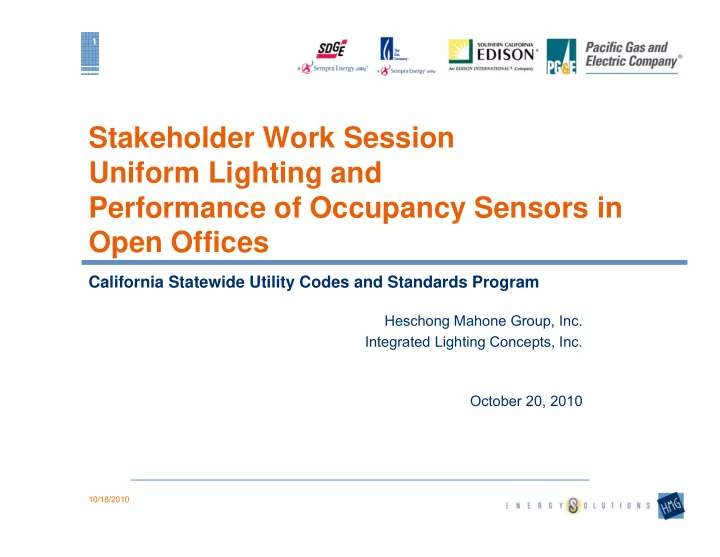

1 Stakeholder Work Session Uniform Lighting and Performance of Occupancy Sensors in Open Offices California Statewide Utility Codes and Standards Program Heschong Mahone Group, Inc. Integrated Lighting Concepts, Inc. October 20, 2010 10/18/2010
2 CALIFORNIA STATEWIDE UTILITIES CODES AND STANDARDS PROGRAM Uniformity and Occ Sensor Performance Agenda ● Review the assumptions involved in how designers will meet the revised LPDs for open office lighting: ● Use of task-ambient lighting ● Use of fine-grained occupancy controls ● Use of highly efficient fixtures ● Review proposed language to replace the “uniformity” requirement in section 131(b) (Multi-level switching). ● How should a requirement for uniform lighting apply in photocontrolled areas? CA Utilities 2011 Title 24 Stakeholder Meeting for Proposed Code Changes 10/20/2010
3 CALIFORNIA STATEWIDE UTILITIES CODES AND STANDARDS PROGRAM Uniformity and Occ Sensor Performance Agenda (continued) ● Discuss the effectiveness of fine-grained control based on occupancy in open offices: ● Equipment and commissioning required to exclude false triggering ● Availability and price of equipment ● Non-energy effects, acceptability to end users CA Utilities 2011 Title 24 Stakeholder Meeting for Proposed Code Changes 10/20/2010
4 CALIFORNIA STATEWIDE UTILITIES CODES AND STANDARDS PROGRAM Uniformity and Occupancy Sensor Performance Meeting Revised Office LPDs ● Proposed Open Office LPD, Overhead + Task = 0.8 + 0.3 W/ft² ● Methods of meeting proposed LPD (without daylighting controls or manual controls) Option 1 Task/Ambient Recessed: Overhead + Task 0.51 + 0.13 W/ft² Option 2 Task/Ambient Suspended: Overhead + Task 0.75 + 0.13 W/ft² Option 3 2 Workstations per Occupancy Sensor: 0.45 0.79 W/ft² W/ft²+(0.45x (1 – 0.25 PAF)) Option 4 High Efficiency Recessed 0.52 W/ft² Option 5 High Efficiency Suspended 0.68 W/ft² CA Utilities 2011 Title 24 Stakeholder Meeting for Proposed Code Changes 10/20/2010
5 CALIFORNIA STATEWIDE UTILITIES CODES AND STANDARDS PROGRAM Uniformity and Occupancy Sensor Performance Current Proposed Language for Uniformity ● 131(b) Multi-Level Lighting Controls. “ The general lighting of any space 100 square feet or larger… Multi-level lighting controls shall also comply with uniformity requirements of Table 131-A ”. Luminaire Type Minimum Required Multi- Uniform level of illuminance shall Level Control Steps: be achieved by: Continuous dimming - 10- Continuous dimming Incandescent, halogen, and 100% of Full Power LED lamps Stepped dimming, continuous Fluorescent linear (including Full 1 , High 2 , Medium 3 , Low 4 dimming, switching alternate lamps in U-bent) lamps > 13 watts; a luminaire 5 induction lamps >25 watts Note that there is no requirement for “uniformity” in the sense ● used by IESNA (E min /E max ) Checkerboard and alternate rows are proposed to be eliminated ● as options, so this is a more stringent requirement for uniformity than in 2008 CA Utilities 2011 Title 24 Stakeholder Meeting for Proposed Code Changes 10/20/2010
6 CALIFORNIA STATEWIDE UTILITIES CODES AND STANDARDS PROGRAM Uniformity and Occupancy Sensor Performance Concerns Regarding Uniformity ● The effect of fine-grained occupancy sensor control ● This will reduce light levels in unoccupied work areas ● It should not significantly affect the amount or uniformity of light available in occupied areas ● No requirement for uniformity is proposed. Is this adequate? ● The effect of photocontrols ● Photocontrols reduce electric light uniformity, but optimize total uniformity ● There is no proposed uniformity requirement for photocontrols. Is this adequate? ● We believe that this requirement allows switching controls for daylighting. Is this appropriate? CA Utilities 2011 Title 24 Stakeholder Meeting for Proposed Code Changes 10/20/2010
CALIFORNIA STATEWIDE UTILITIES CODES AND STANDARDS PROGRAM Uniformity and Occupancy Sensor Performance Occupancy Sensor Performance Standard ceiling-mounted occupancy sensors give slightly too large an area of ● coverage—they would require a shield or lens for smaller control groups. What equipment is available to achieve this? ● Does it add cost to the sensor? ● Does this approach work reliably and achieve acceptance? ● How could an acceptance test be worded? ● CA Utilities 2011 Title 24 Stakeholder Meeting for Proposed Code Changes 10/20/2010
CALIFORNIA STATEWIDE UTILITIES CODES AND STANDARDS PROGRAM Uniformity and Occupancy Sensor Performance Occupancy Sensor Performance ● In speculative offices, the occupancy sensor grid may not match the cubicle layout ● This will compromise savings ● HMG will attempt to quantify the loss of savings and modify the allowed PAF ● How could the PAF language distinguish between aligned and non-aligned grids? ● Should an acceptance test be required? CA Utilities 2011 Title 24 Stakeholder Meeting for Proposed Code Changes 10/20/2010
9 CALIFORNIA STATEWIDE UTILITIES CODES AND STANDARDS PROGRAM Uniformity and Occupancy Sensor Performance Data Requests ● Need model numbers, cut sheets and pricing for occupancy sensors that can cover small areas: ● Single cubicle ● Two cubicles ● Four cubicles ● If these products are not available off the shelf we need an estimate of price increment and of production volume capability from several manufacturers (independently) CA Utilities 2011 Title 24 Stakeholder Meeting for Proposed Code Changes 10/20/2010
10 CALIFORNIA STATEWIDE UTILITIES CODES AND STANDARDS PROGRAM QUESTIONS & COMMENTS CA Utilities 2011 Title 24 Stakeholder Meeting for Proposed Code Changes 10/20/2010
Recommend
More recommend